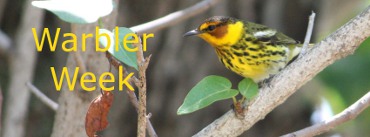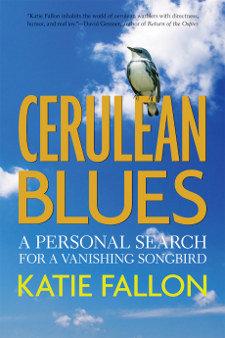Reviewed by Grant McCreary on May 7th, 2012.
It’s an inescapable truth that having children means that you will become more familiar with kids’ TV shows than you ever wanted to. The most surprising thing to me – after discovering how annoyed I get over some of the more ludicrous plot holes, especially on Mickey Mouse Clubhouse – is how many episodes of various shows deal with birds and birdwatching. Curious George, one of my daughter’s favorites, has several such episodes. In one, The Man in the Yellow Hat, George’s owner, writes a book about the Cerulean Warbler – “Everything you wanted to know about the Cerulean Warbler in just 1400 pages!” My first thought when I saw that was “Wow, I’d love to read that!” But, of course, that book didn’t exist. No matter now, because we have Cerulean Blues: A Personal Search for a Vanishing Songbird.
Cerulean Warblers are amazing birds. Visually, they stand out even amongst the striking birds that are the wood-warblers. They undertake a mind-boggling migration (that includes crossing the Gulf of Mexico!) twice each year. And, unfortunately, they are uncommon and declining. Ceruleans are high on any birder’s want list, and seeing one is almost always the highlight of a birding day. So it’s not really surprising that Katie Fallon wrote a book about them. What was surprising, however, is that she was researching (read: obsessing about) the bird and planning this book even before she had actually seen a Cerulean Warbler. But, then again, Ceruleans can have that effect on people.
Cerulean Blues begins with a quick overview of the Cerulean Warbler in American ornithology, including its treatment by Alexander Wilson, Audubon, Bent, and Paul Hamel, the author of its Birds of North America account and the “godfather of cerulean warblers”.
When it comes to describing how and where the bird lives, Fallon doesn’t simply regurgitate the facts. Instead, in a narrative that is divided into the seasons of the Cerulean Warbler’s life – spring, summer, and fall – she takes us to the warbler. She joins a research team in West Virginia and helps capture and band warblers. Later, she hopes to see fledgling Ceruleans at a study site in Tennessee where other researches have been attempting to discover the bird’s nesting habitat preferences. And finally, she attends a conference on Cerulean Warblers in Colombia and tours the Cerulean Warbler Reserve, the first South American reserve for a bird that breeds in North America.
Cerulean Blues is not meant to be an exhaustive natural history of the Cerulean Warbler. But you’ll still learn much about this bird as information is related along the way, including some really interesting facts. For example, Fallon learns that nests are usually above open areas and relays:
Female cerulean warblers have been observed “bungee jumping” from their nests down into this open area below; the female birds suddenly “fall” from their nests headfirst toward the ground before zipping away into the undergrowth just before impact. Some biologists think the females may be imitating falling leaves in an attempt to depart from their nests unnoticed.
In the Curious George cartoon, The Man in the Yellow Hat wrote his book to draw attention to the plight of the Cerulean Warbler. Fallon was motivated by the same thing. It really is alarming—the Cerulean Warbler population is declining by about 3% a year, which means that there are now 80% fewer than there were just 40 years ago. The main threats seem to be mountaintop removal mining in their breeding range and full-sun coffee plantations in Central and South America where they winter. The author goes into detail on each, sometimes painfully so:
It was tragically poetic—as I stood staring at a mountaintop removal mine, the fastest-declining warbler in the United States sang above me. How many ceruleans had once claimed territories on that opposite ridge? Where were they now? Had they returned from South America only to find their instinctual breeding grounds completely gone, destroyed by the very mine I was photographing?
Arguably, the most important word in this book’s title is personal. Fallon often shares things unrelated to the topic at hand, from the efficacy (or lack thereof) of a new deodorant she was trying out, to her experience during and after the horrible shootings at Virginia Tech, where she was teaching at the time. Rather than distractions, I felt these were nice touches that really added to the story. As Cynthia Ellis commented on this site’s Facebook page, Katie Fallon poured her “heart and soul” into this book. That much is made clear very early on in this book and reaffirmed with every page read.
As we’ve seen, Cerulean Blues contains travel narrative, natural history information, conservation threats, and personal observations and circumstances. This could have been a complete mess, but Fallon skillfully weaves these disparate threads together into a story that is a pleasure to read. I found it extremely well-written, but I suppose that should be expected since the author is an English professor.
Recommendation
At the end of the Curious George episode, after they’ve succeeded in getting a book store to carry the Cerulean Warbler book, the owner of the store says that “[the book] made me laugh, it made me cry, it made me give half the proceeds to The Warbler Foundation”. Trite, maybe, but I can honestly make that claim about the book reviewed here. Cerulean Blues made me laugh and cry, and even moved me to make a donation (but to an actual organization) and look into further ways that I can help this imperiled bird. And that – even beyond being entertaining, informative, and beautifully written – is the true value of this book. I think anyone, whether or not they particularly like birds, would enjoy this book. But those that do like birds, especially the enchanting Cerulean Warbler, or are concerned about bird conservation in general need to read Cerulean Blues.
 This review is a part of Warbler Week – a celebration of warblers in print and other media.
This review is a part of Warbler Week – a celebration of warblers in print and other media.
Disclosure: I get a small commission for purchases made through links in this post.
Disclosure: The item reviewed here was a complementary review copy provided by the publisher. But the opinion expressed here is my own, it has not been influenced in any way.



[…] can read the rest of that review here. TweetFacebookLinkedInTumblrStumbleDiggDelicious This entry was tagged Cerulean Blues, Fallon, […]